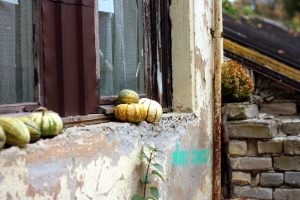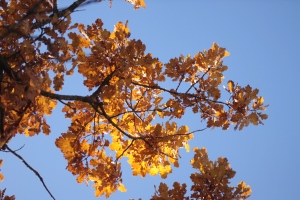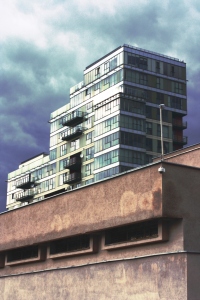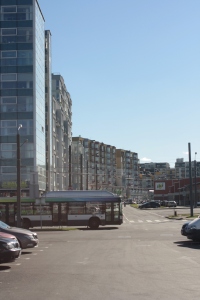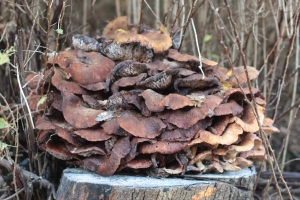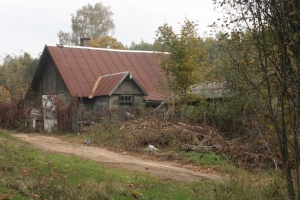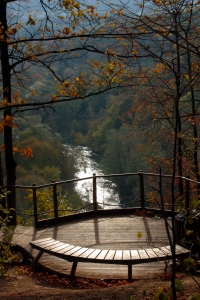Halloween in Lithuania, like anywhere else in the world, is mostly a marketing gimmick. The supermarkets have a corner dedicated to ‘ween kitch – witches’ hats, plastic spiders, “scream” masks and orange sweets. But it remains a niche celebration. What isn’t niche, in this country of impressive graveyards, is the original theme behind halloween, namely the celebration of the spirits of those that have passed. If a corner in a supermarket is dedicated to the US version, an entire department is dedicated to candles, which will be deposited among the many graveyards in the country in the coming week. Traffic jams the roads outside major cemeteries, which glitter in a sea of candlelight. As a bonus, Lithuanian pumpkins are generally without a grisly face carved into them, and are instead left to serve their primary purpose as a delicious autumn ingredient. Top tip: bake a carrot cake, just replace the carrot with shredded pumpkin. The result is amazing! This photo is of the abandoned farm in the back of Sapiegų rūmų parkas in Antakalnis.
Monthly Archives: October 2015
A country full of Ąžuolas
The oak is, without doubt, the grandmaster of trees, and their magnificence is attested in countless legends. Lithuania seems to have an unusually large number of oaks – large ones in particular. Across Europe, oak populations were pillaged to the point of no return until riveted metal ships started to replace hardwood ones, around the end of the 1800s. As a result, the oaks that now grow are either younger than a century, or in the case of mature trees, few and far between. For whatever reason that a quick google and a chat over a beer won’t reveal, Lithuania is full of oaks. Young ones, like the rest of Europe, but also old ones. Whatever the reason, the frequent, and particularly appealing tan of autumn oak leaves filtering the sun on a frosty autumn morning is a slice of Lithuania that will linger for years to come.
Zipping in the woods
One thing Lithuania has definitely gotten right is the design of rope courses. Uno Parkas runs a franchise of these courses in the outskirts of major cities and tourist centres and while I will happily confess to not being an expert in the genre, the courses are great fun, and I haven’t come across anything quite as enjoyable – and affordable elsewhere. This particular course happened to have a spider-themed design entirely appropriate for the Halloween season. The courses are best enjoyed from the age of around five or six, when you’re able to manage a couple of clips to keep you safe, and from there there is seemingly no upper limit to how advanced the courses go. On many of the parks, you can zip across a river, or try out the “elephant jump” – a tree-based spin on bungee jump. And though admittedly more expensive than a trip foraging for mushrooms in the forest, the modest fee won’t be wasted.
Sprouting glass from cement
In Vilnius, old and new interplay with each other in sometimes surprisingly easy and pleasing ways. On the north bank of the Neris, an old concrete foundation aligns perfectly with the contemporary apartments behind it. Mixing and matching the old and new can work, and in Vilnius, in many cases it does work in symphony.
Lithuania’s handheld snacking devices
Having sampled apples in many countries, I can happily report that the ones growing in Lithuania are top of the class for taste. Not surprisingly, perhaps, since its southern neighbour Poland is the world’s third-largest apple producer. Lithuanian apples are, perhaps, not the best in the world, or even Europe, but they can certainly fight their corner compared to apples from further afield. They are small and sweet, with a soft, mottled yellow-and-red skin, just about the right size for a quick snack. They are not as waxy and shiny as big-brand apple varieties that have conquered supermarkets around the world. Nor are they big and crunchy. And often they’ve taken a dent. But for sheer taste, they beat all their better-looking rivals. As a bonus Lithuanian “bag in box” apple juice is cheap and widely sold in markets and shops, concentrating the apple goodness in drinkable form. I would be surprised if Lithuanian apples would be sold elsewhere, so you’d have to treat yourself on location.
Oblast from the past
The park nicknamed “Stalin World” a short drive outside Vilnius must rank as one of the most disturbing places to visit in the world. Grūtas Parkas, as it is formally named, is a dumping ground for all the Soviet memorabilia adorning Lithuania that wasn’t destroyed as the USSR disintegrated. As if having pointy-chinned statues of Vladimir Lenin, and the face of Joseph Stalin staring into the middle-distance in a vast swamp wasn’t strange enough, Grūtas has topped up the “experience” with a “mini-zoo” worthy of a PETA raid, and a wonderful playground of oversized, brightly-coloured swings and carousels to add what can best be described as “contrast” to the main exhibition. Having said that, the place is definitely worth a visit. It has, on-site, a “Gulag” train, that would have shipped some of the 350,000 Lithuanians that died in the infamous Soviet work camps in Siberia to their grisly destination. The statues themselves are annotated with details of the artist and/or subject, often spelling out how they met their end at the hands of Lithuanian nationalists, Soviet military hardware or anonymity. There is something that chills the soul, in a massive statue of a character like Lenin, Stalin, Marx or Engels, or any of the other people that helped the Soviet state strike a chilling fear into the Lithuanian nation, staring into the misty forest in a bog, The statues are laden with all the symbolism and history of the “LTSR” era, and would previously have been overlooking a city square, or bridge. To top up the oversized sculptures, which ironically also showcase the extraordinary beauty and skill of Soviet art and design, Grūtas also has indoor exhibitions showcasing the propaganda booklets, cheery Soviet paragons like Olympic bears and paintings of patriotic communal farmers, that stood at the centre of Soviet state ideology. The “zoo” deserves little mention, other than a warning that it may upset some viewers. And the playground is absolutely fantastic, if you can stomach it among the rest of the exhibit. I suppose it’s good, “for the record”, that the statues and exhibits exists for posterity, and not destroyed altogether. However, I can’t help but wonder whether this “educational” exercise is better done in the public interest by – say – Lithuania’s museums – rather than as a private, for-profit exercise with unknown, and potentially dubious subtexts. For anyone wanting to shake loose of all the dark thoughts and re-assert their neoliberal bent, 15 minutes drive away from the park, in the spa resort of Druskininkai, is a gargantuan – to the point of absurd – indoor skiing resort; extravagant aqua park; luxury spas; and top-of-its-class tree rope course. And as a disclaimer, I’m aware that this is not strictly “Vilnius”. But I will allow entries like this, that are a day-trip away from the Lithuanian capital, if they are particularly noteworthy.
Žirmūnai – neither here nor there
There are some quarters in a city that visitors are unlikely to ever see. In Vilnius, the Northern half of Žirmūnai, hugging the right bank of the Neris upstream from the centre, is just that. The former barracks district is in many respects an entirely unremarkable part of town from a visitor’s point of view, but it could equally be described as the beating heart of the city for people who live here. Upstream from Šilo bridge on the river’s right bank, is a 21st century version of urban planning that in many respects shares many features with its authoritarian predecessor. Blocks of flats; functional and efficient infrastructure with little attention paid to aesthetics; and local services that allows the zone to be self-contained. But rather than reinforced concrete as its pre-1980s predecessors, this 21st century microdistrict has steel and glass as its hallmark. The main housing type consists of seven- to eight-story apartment complexes, built around a parking lot and a playground. The odd high-rise tower is dotted around the zone, and the rest is filled up with multi-lane road arteries that connect the contemporary housing with the centre, and local commerce and services. At the centre of it all is Ogmios Miestas – a 20 hectare zone of brightly coloured warehouses and gleaming hypermarkets dedicated to commerce and entertainment. This commercial hub draws crowds from across Vilnius, but doesn’t have enough pull factor to draw cars with license plates from Belarus, Russia, Poland or the rest of the Baltics. Its status as visitor blind spot is reinforced by the lack of motorways or other thoroughfares, meaning that unless you have a reason to go, there’s little chance you will pass through. If you have a reason to go, though, there’s plenty to explore with a bit of Internet browsing time on your hands and a decent map.
Mushroom to spare
A common entry on english-language Lithuanian restaurant menus in autumn is “Boletus” in a variety of forms. To many, the word is unfamiliar (errm, some traditional version of meatballs, perhaps?). But once served, it’s instantly recognizable as the woody, warm, rich taste of “penny bun” mushrooms – a food with many sobriquets but can best be described as “forest mushrooms” to the newbie. Boletus are a group of mushrooms, of which Porcini is probably the best known, but also comprises a number of other less well-known brands, few of which are likely to be sold next to the blue box of button mushrooms in the supermarket. So far, the best experience of Lithuanian cooking with “Baravykas” shrooms has been in the form of a rich, creamy soup. But other variants exist, including boletus-stuffed chicken and boletus sandwich. If you happen to be in Lithuania, from late September until the winter really sets in, it would be a culinary crime to miss this delicious treat. The fungus in the accompanying picture has no relation to its edible cousins, but was extraordinarily pretty, where it grew along a street in Antakalnis on a frosty morning.
Old wooden houses
A common sight around Vilnius are old wooden houses that in some places sit wedged between gleaming skyscrapers and apartment blocks. The houses have a peculiar style, with pointy roofs and low outside walls, woodwork throughout and in most cases, a few missing window panes and a door barely able to hang on to its hinges. In some cases, the houses are refurbished, into perfectly livable single-family homes. In other cases, they are left in their delapidated state. And in many others, the old wood has been levelled to give way to a block of flats. As a result, it would be fair to assume that these houses will be fewer in a decade, but until they are gone or done up, they offer a sober reminder that Lithuania’s wealth is both new and unevenly spread. This particular house is located in the Pavilnių regional park.
Vertigo in Pūčkoriai
One of the most lovely places near Vilnius to visit on a clear day is the viewing platform on top of the Pūčkorių exposure. From the top of the near-vertical 65 metre drop, carved out of the sandy ridge by a bend in the Vilniai river, you are offered a magnificent view of the river, the southern part of the Pavilniai regional park, and the old Belmontas mill and cannon foundry. But if you suffer from vertigo, it’s perhaps safer to wander along the exquisite forest paths and, head down to the Belmontas heritage site, and look up towards the escarpment instead.
